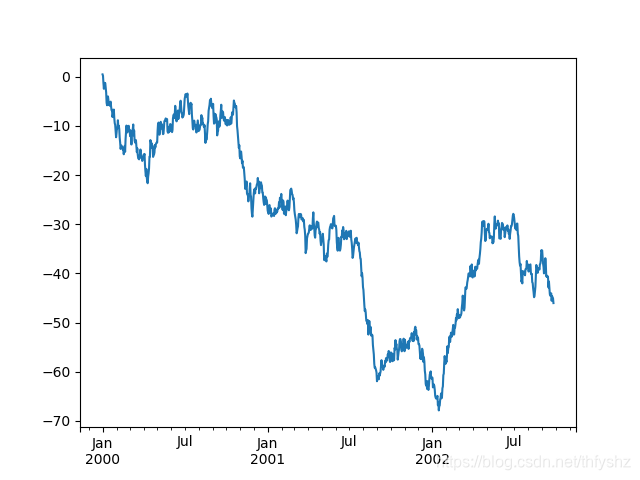pandas縱向學習之10 minutes to pandas(四)
阿新 • • 發佈:2018-11-14
時間序列
resample函式的用法:
In [14]: rng = pd.date_range('1/1/2012', periods=100, freq='S')
In [15]: ts = pd.Series(np.random.randint(0, 500, len(rng)), index=rng)
#以五分鐘為間隔,並加總。由於是隨機生成的,所以每次結果可能不同
In [16]: ts.resample('5Min').sum()
Out[16]:
2012-01-01 25820
Freq: 5T, dtype: int32
In [17]: ttt = pd.date_range( 利用tz_localize和tz_convert函式轉化時區:
In [111]: rng = pd.date_range('3/6/2012 00:00', periods=5, freq='D')
In [112]: ts = 不同時間型別的轉化,參考Python時間轉換:
In [117]: rng = pd.date_range('1/1/2012', periods=5, freq='M')
In [118]: ts = pd.Series(np.random.randn(len(rng)), index=rng)
In [119]: ts
Out[119]:
2012-01-31 -1.134623
2012-02-29 -1.561819
2012-03-31 -0.260838
2012-04-30 0.281957
2012-05-31 1.523962
Freq: M, dtype: float64
In [120]: ps = ts.to_period()
In [121]: ps
Out[121]:
2012-01 -1.134623
2012-02 -1.561819
2012-03 -0.260838
2012-04 0.281957
2012-05 1.523962
Freq: M, dtype: float64
In [122]: ps.to_timestamp()
Out[122]:
2012-01-01 -1.134623
2012-02-01 -1.561819
2012-03-01 -0.260838
2012-04-01 0.281957
2012-05-01 1.523962
Freq: MS, dtype: float64
In [123]: prng = pd.period_range('1990Q1', '2000Q4', freq='Q-NOV')
In [124]: ts = pd.Series(np.random.randn(len(prng)), prng)
In [125]: ts.index = (prng.asfreq('M', 'e') + 1).asfreq('H', 's') + 9
In [126]: ts.head()
Out[126]:
1990-03-01 09:00 -0.902937
1990-06-01 09:00 0.068159
1990-09-01 09:00 -0.057873
1990-12-01 09:00 -0.368204
1991-03-01 09:00 -1.144073
Freq: H, dtype: float64
分類
In [127]: df = pd.DataFrame({"id":[1,2,3,4,5,6], "raw_grade":['a', 'b', 'b', 'a', 'a', 'e']})
In [128]: df["grade"] = df["raw_grade"].astype("category")
In [129]: df["grade"]
Out[129]:
0 a
1 b
2 b
3 a
4 a
5 e
Name: grade, dtype: category
Categories (3, object): [a, b, e]
In [130]: df["grade"].cat.categories = ["very good", "good", "very bad"]
In [131]: df["grade"] = df["grade"].cat.set_categories(["very bad", "bad", "medium", "good", "very good"])
In [132]: df["grade"]
Out[132]:
0 very good
1 good
2 good
3 very good
4 very good
5 very bad
Name: grade, dtype: category
Categories (5, object): [very bad, bad, medium, good, very good]
In [133]: df.sort_values(by="grade")
Out[133]:
id raw_grade grade
5 6 e very bad
1 2 b good
2 3 b good
0 1 a very good
3 4 a very good
4 5 a very good
In [134]: df.groupby("grade").size()
Out[134]:
grade
very bad 1
bad 0
medium 0
good 2
very good 3
dtype: int64
畫圖
隨機遊走並累計加總:
In [135]: ts = pd.Series(np.random.randn(1000), index=pd.date_range('1/1/2000', periods=1000))
In [136]: ts = ts.cumsum()
In [137]: ts.plot()
Out[137]: <matplotlib.axes._subplots.AxesSubplot at 0x7f213444c048>

In [138]: df = pd.DataFrame(np.random.randn(1000, 4), index=ts.index,
.....: columns=['A', 'B', 'C', 'D'])
.....:
In [139]: df = df.cumsum()
In [140]: plt.figure(); df.plot(); plt.legend(loc='best')
Out[140]: <matplotlib.legend.Legend at 0x7f212489a780>

匯入與匯出
簡單瞭解即可:
In [145]: df.to_excel('foo.xlsx', sheet_name='Sheet1')
In [146]: pd.read_excel('foo.xlsx', 'Sheet1', index_col=None, na_values=['NA'])
